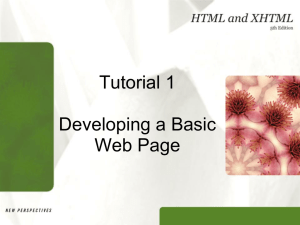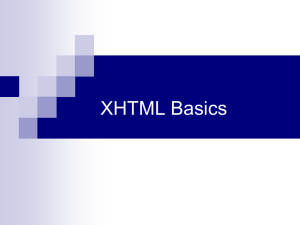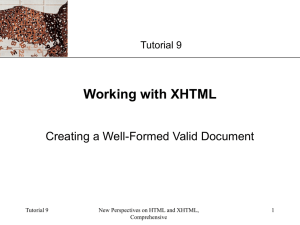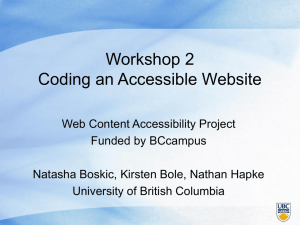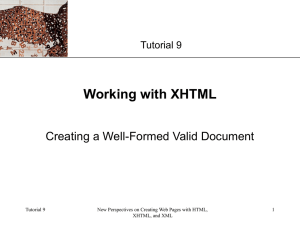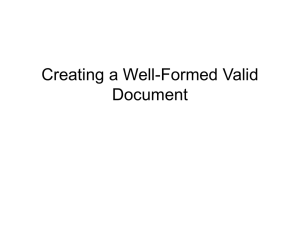Tutorial 7 Presentation
advertisement
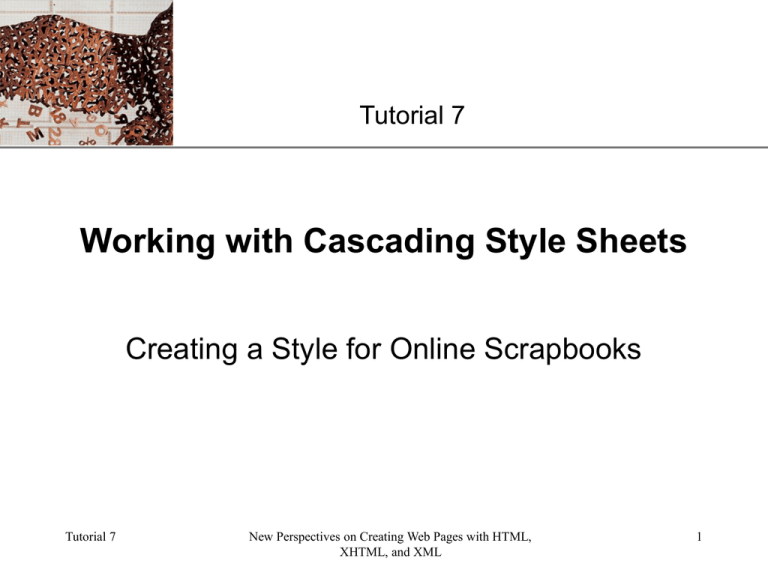
XP
Tutorial 7
Working with Cascading Style Sheets
Creating a Style for Online Scrapbooks
Tutorial 7
New Perspectives on Creating Web Pages with HTML,
XHTML, and XML
1
XP
Objectives
•
•
•
•
•
•
Introducing Cascading Style Sheets
Using Inline Styles
Using Embedded Styles
Using an External Style Sheet
Understanding Cascading Order
Working with Selectors
Tutorial 7
New Perspectives on Creating Web Pages with HTML,
XHTML, and XML
2
XP
Objectives
•
•
•
•
•
•
•
•
Using IDs and Classes
Sizing Elements
Floating an Element
Working with the div Element
Setting the Display Style
Working with the Box Model
Using Pseudo-Classes and Pseudo-Elements
Applying a Style to a Web Site
Tutorial 7
New Perspectives on Creating Web Pages with HTML,
XHTML, and XML
3
XP
Objectives
•
•
•
•
•
•
Positioning Objects with CSS
Working with Overflow and Clipping
Stacking Elements
Working with Different Media
Hiding Elements
Using Print Styles
Tutorial 7
New Perspectives on Creating Web Pages with HTML,
XHTML, and XML
4
Introducing Cascading Style XP
Sheets
• Style sheets are files or forms that describe
the layout and appearance of a document
• Cascading Style Sheets, or CSS, is a style
sheet language used on the Web
– CSS specifications are maintained by the World
Wide Web Consortium (W3C)
– Three versions of CSS exist: CSS1, CSS2, and
CSS3
Tutorial 7
New Perspectives on Creating Web Pages with HTML,
XHTML, and XML
5
XP
Cascading Style Sheets
• CSS1 introduced styles for the following
document features:
– Fonts
– Text
– Color
– Backgrounds
– Block-level Elements
Tutorial 7
New Perspectives on Creating Web Pages with HTML,
XHTML, and XML
6
XP
Cascading Style Sheets
• CSS2 introduced styles for the following
document features:
– Positioning
– Visual Formatting
– Media Types
– Interfaces
Tutorial 7
New Perspectives on Creating Web Pages with HTML,
XHTML, and XML
7
XP
Cascading Style Sheets
• CSS3 (which is still in development) will
introduce styles for the following
document features:
– User Interfaces
– Accessibility
– Columnar layout
– International Features
– Mobile Devices
– Scalable Vector Graphics
Tutorial 7
New Perspectives on Creating Web Pages with HTML,
XHTML, and XML
8
XP
Applying a Style Sheet
• Three ways to apply a style to an HTML
or XHTML document:
– Inline Styles
– Embedded Styles
– External Styles
Tutorial 7
New Perspectives on Creating Web Pages with HTML,
XHTML, and XML
9
XP
Using Inline Styles
• Inline styles are easy to use and interpret
because they are applied directly to the
elements they affect.
<element style=“style1: value1; style2:
value2; style3: value3;…”>
Tutorial 7
New Perspectives on Creating Web Pages with HTML,
XHTML, and XML
10
XP
Using Embedded Styles
• You can embed style definitions in a
document head using the following form:
<style>
style declarations
</style>
Where style declarations are the declarations of the
different styles to be applied to the document
Tutorial 7
New Perspectives on Creating Web Pages with HTML,
XHTML, and XML
11
XP
Using an External Style Sheet
• Because an embedded style sheet only applies
to the content of the start.htm file, you need to
place a style declaration in an external style
sheet to apply to the headings in the rest of the
Web site
• An external style sheet is a text file that
contains style declarations
– It can be linked to any page in the site, allowing the
same style declaration to be applied to the entire site
Tutorial 7
New Perspectives on Creating Web Pages with HTML,
XHTML, and XML
12
XP
Using an External Style Sheet
• You can add style comments as you
develop an external style sheet
• Use the link element to link a Web page
to an external style sheet
• You can import the content of one style
sheet into another
Tutorial 7
New Perspectives on Creating Web Pages with HTML,
XHTML, and XML
13
XP
Understanding Cascading Order
• You can link a single style sheet to
multiple documents in your Web site by
using the link element or the @import
element
• You can also link a single document to
several style sheets
Tutorial 7
New Perspectives on Creating Web Pages with HTML,
XHTML, and XML
14
XP
Applying a single style sheet to
multiple documents
Tutorial 7
New Perspectives on Creating Web Pages with HTML,
XHTML, and XML
15
Applying multiple sheets to aXP
single document
Tutorial 7
New Perspectives on Creating Web Pages with HTML,
XHTML, and XML
16
XP
Style Precedence
1. External style sheet
2. Embedded styles
3. Inline styles
Tutorial 7
New Perspectives on Creating Web Pages with HTML,
XHTML, and XML
17
XP
Style Inheritance
•
If a style is not specified for an element,
it inherits the style of its parent element;
This is called style inheritance.
Tutorial 7
New Perspectives on Creating Web Pages with HTML,
XHTML, and XML
18
XP
Working with Selectors
•
•
CSS allows you to work with a wide
variety of selectors to match different
combinations of elements
Use contextual selectors to apply a
style based on the context in which an
element is used
Tutorial 7
New Perspectives on Creating Web Pages with HTML,
XHTML, and XML
19
XP
Simple and contextual selectors
Tutorial 7
New Perspectives on Creating Web Pages with HTML,
XHTML, and XML
20
XP
Attribute Selectors
•
Create an attribute selector to select
an element based on the element’s
attributes
– See figure 7-13 in your text for a list of
attribute selectors
Tutorial 7
New Perspectives on Creating Web Pages with HTML,
XHTML, and XML
21
XP
Using IDs and Classes
• Use an id to distinguish something, like
a paragraph, from the others in a
document
– For example, to identify a paragraph as
“head”, use the code:
<p id=“head”>… </p>
Tutorial 7
New Perspectives on Creating Web Pages with HTML,
XHTML, and XML
22
XP
Classes
• HTML and XHTML require each id be
unique– therefore an id value can only
be used once in a document
• You can mark a group of elements with
a common identifier using the class
attribute
<element class=“class”> … </element>
Tutorial 7
New Perspectives on Creating Web Pages with HTML,
XHTML, and XML
23
XP
Applying a style to a class
Tutorial 7
New Perspectives on Creating Web Pages with HTML,
XHTML, and XML
24
Applying a style to a class andXP
element
Tutorial 7
New Perspectives on Creating Web Pages with HTML,
XHTML, and XML
25
XP
Sizing Elements and Floating an
Element
•
You can define the width of columns in a
columnar layout using: width: value
•
You can use CSS to set an element’s height
using: height: value
You can float a paragraph using: float:
position
•
Tutorial 7
New Perspectives on Creating Web Pages with HTML,
XHTML, and XML
26
XP
Working with the div Element
•
The div element is a generic block-level
element
<div>
content
</div>
Tutorial 7
New Perspectives on Creating Web Pages with HTML,
XHTML, and XML
27
XP
Setting the Display Style
Values of the display style
Tutorial 7
New Perspectives on Creating Web Pages with HTML,
XHTML, and XML
28
XP
Setting the Display Style
Values of the display style
Tutorial 7
New Perspectives on Creating Web Pages with HTML,
XHTML, and XML
29
XP
Working with the Box Model
•
The box model is an element composed of
four sections:
–
–
–
–
Tutorial 7
Margin
Border
Padding
content
New Perspectives on Creating Web Pages with HTML,
XHTML, and XML
30
XP
The Box Model
Tutorial 7
New Perspectives on Creating Web Pages with HTML,
XHTML, and XML
31
XP
Working with the Box Model
•
Styles to set padding are similar to styles to
set margins:
–
–
–
–
Tutorial 7
padding-top: value
padding-right: value
padding-bottom: value
padding-left: value
New Perspectives on Creating Web Pages with HTML,
XHTML, and XML
32
XP
Border Styles
Tutorial 7
New Perspectives on Creating Web Pages with HTML,
XHTML, and XML
33
XP
Border Style Types
Tutorial 7
New Perspectives on Creating Web Pages with HTML,
XHTML, and XML
34
Using Pseudo-Classes and
Pseudo-Elements
•
XP
A pseudo-class is a classification of an element
based on its status, position, or current use in the
document
Tutorial 7
New Perspectives on Creating Web Pages with HTML,
XHTML, and XML
35
Using Pseudo-Classes and
Pseudo-Elements
•
•
XP
Rollover effects can be created using pseudo-classes
Pseudo-elements are elements based on information
about an element’s content, use or position
Tutorial 7
New Perspectives on Creating Web Pages with HTML,
XHTML, and XML
36
XP
Positioning Objects with CSS
•
•
The different positioning styles in the original
CSS1 specifications were known as CSSPositioning or CSS-P
To place an element at a specific position on
a page use:
position: type; top: value; right: value;
bottom: value; left: value;
Tutorial 7
New Perspectives on Creating Web Pages with HTML,
XHTML, and XML
37
Working with Overflow and
Clipping
•
XP
The overflow property syntax:
overflow: type
Tutorial 7
New Perspectives on Creating Web Pages with HTML,
XHTML, and XML
38
XP
Stacking Elements
•
Specify stacking order with:
z-index: value
z-index: 1
z-index: 3
z-index: 2
Tutorial 7
New Perspectives on Creating Web Pages with HTML,
XHTML, and XML
39
XP
Working with Different Media
•
Tutorial 7
Specify output styles for particular devices in the
media attribute of the link and style elements
New Perspectives on Creating Web Pages with HTML,
XHTML, and XML
40
XP
The @media Rule
•
You can also specify the output media within
a style sheet using:
@media type {style declarations}
Where media is one of the supported media types
and style declarations are the styles
associated with that media type
Tutorial 7
New Perspectives on Creating Web Pages with HTML,
XHTML, and XML
41
XP
Media Groups
•
CSS2 uses media groups to describe basic
facets of different media– and to differentiate
between different types of media based on
the ways they render content
–
–
–
–
Tutorial 7
Continuous or paged
Visual, aural, or tactile
Grid (for character grid devices) or bitmap
Interactive or static
New Perspectives on Creating Web Pages with HTML,
XHTML, and XML
42
XP
Media Groups
Tutorial 7
New Perspectives on Creating Web Pages with HTML,
XHTML, and XML
43
XP
Hiding Elements
•
Two different styles that allow you to hide
elements:
– Display style
– Visibility style
Tutorial 7
New Perspectives on Creating Web Pages with HTML,
XHTML, and XML
44
Comparing the visibility and XP
display styles
Tutorial 7
Visibility hidden
Display: none
Object is hidden but still is
part of the page flow
Object is hidden and is
removed from the page flow
New Perspectives on Creating Web Pages with HTML,
XHTML, and XML
45
XP
Using Print Styles
•
•
You can specify the size of a page, margins,
internal padding, etc. of the page box
Review the Reference Window on page
HTML 420 for working with print styles
Tutorial 7
New Perspectives on Creating Web Pages with HTML,
XHTML, and XML
46
